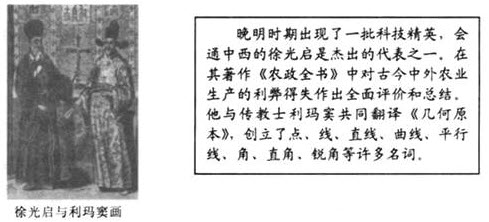材料一:

材料二:“美国宪法是人类法制文明史上的重要里程碑。它的制定将从欧洲文艺复兴时代以来有关人类对理性政治的思考变成了现实的政治原则,使这些伟大的思想在政治实践中获得发扬光大。”
——马啸原《西方政治制度史》
材料三:20世纪初,在中国文化思想界出现了这样的一种思想:“世称近世欧洲历史为“解放历史”——破坏君权,求政治之解放也;否认教权,求宗教之解放也;……解放云者,脱离夫奴隶之羁绊,以完其自主自由之人格之谓也。士不知科学,故袭阴阳家符瑞五行之说,惑世诬民……农不知科学,故无择种去虫之术。工不知科学,故货弃于地……医不知科学,既不解人身之构造,复不事药性之分析……夫以科学说明真理,事事求诸证实,……其步步皆踏实地,不若幻想突飞者之终无寸进也。宇宙间之事理无穷,科学领土内之青腴待辟者,正自广阔。青年勉乎哉!”
材料四:“君子不言利”,“安贫乐道”,是中国农耕文明的思想结晶,重农抑商政策的思想基础,严重阻碍了商品经济的发展,使中国在近代市场经济发展的道路上渐行渐远,落后于西方。
“社会主义要蠃得与资本主义相比较的优势,就必须大力吸收和借鉴人类社会创造的一切文明成果,吸收和借鉴当今世界各国包括资本主义发达国家的一切反映现代化生产规律的先进经营方式、管理方式。”
依据材料一归纳晚明时期“西学东渐”主要集中的领域以及产生的影响。
参考答案:
领域:宗教和自然科学领域。
影响:促进中西文化的交流;为中国传统科技注入新机;开阔了当时知识分子的眼界。
